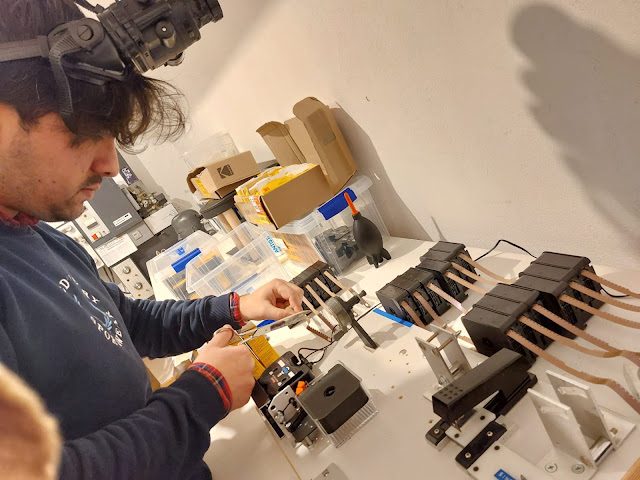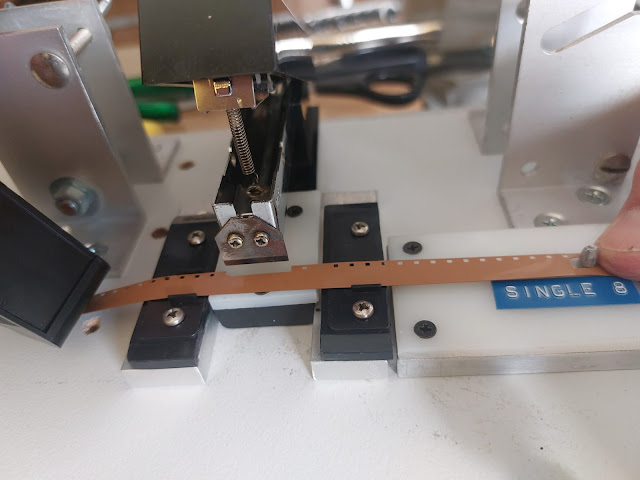Extraordinary success of my almost two hour lecture, with a lot of Kodak film on the table, and the ZC1000N, at the Invercargill Photographic Society, in New Zealand. Its president, and its secretary, the very kind Stephane Forrester, at the end of the dissertation and the colloquium, presented me with a very nice double gift that I will reveal later.
 |
LECTURE.
Many thanks to Stephanie Forrester, and the Southland Photographic Society, not only for hosting me today, for this lecture, but for offering to receive, from Spain, the package with the raw motion picture film stocks vía DHL, and also for being kind enough to to pick me up at the airport and bring me to the hotel, which I appreciate because I am very tired after three days traveling: Invercargill is practically at the antipodes of the Galicia region, in the northwest of Spain: about 20,000 kilometers from my city, La Coruña, with 6 flights, one of them lasting 17 hours.
The reason I have sent the films via DHL Express, instead of taking them with me in hand luggage, as I did before the pandemic, is that now, in many airports, normal X-ray scanners for two-dimensional images, relatively safe for film up to 800 ASA (as long as they are not scanned too many times, as the effect is cumulative), they have been replaced by newer CT scanners that provide inspectors with 3D images, but unfortunately for us, the filmakers using film, fog the unprocessed film with just one scan. With DHL, films are only scanned once during the entire journey, with normal X-rays for a two-dimensional image.
And now, let's see what's in this box with 13 kilos.
Ladies and gentlemen; yes, slide film, from Kodak and Fujifilm, as well as a lot of motion picture film cartridges, with the entire negative and reversal range from Kodak, but also some from Fujifilm, as well as other smaller manufacturers such as OrWo, Foma or Kahl.
SPITSBERGEN, O GARDIÁN DO ARTICO from IB CINEMA Motion Picture Films on Vimeo.
Now I will start to speak about the project. The generic title of the series is Stop Global Warming, which includes a series of feature films on climate change with a special focus on polar areas. The first of them, "Spitsbergen, the Guardian of the Arctic" was released commercially in cinemas and film libraries, won awards at various festivals, and was broadcast last year on Television of Galicia in prime time. We are going to see both the trailer, in Galicia lenguage and English subtitles, and the making of, with English subtitles too, so that you can be seen how, from beginning to end, we have worked with film, fully with photochemical technology.
SPITSBERGEN: MAKING... IN PROGRESS! from IB CINEMA Motion Picture Films on Vimeo.
The second, "Odyssey in Greenland", is already filmed and in post-production work. The third is "Beyond the end of the world", focused on Antarctica. The first two were shot in super 8, with 16 mm film positives for theatrical exhibition and distribution in 16 mm, a film format that, by the way, is one hundred years old this 2023.
I am also going to shoot this third one with Super8 film but not using the Super8 cartridges, that you all remember, with a coaxial axis and a built-in plastic pressor, but with Single8 cartridges, a type of presentation that Fujifilm let die in 2013, but that survives thanks to the fact that various enthusiasts such me we recharged by ourself , as I will explain later.
Although Super 8 and Single8 cartridges use the same pitch, S-perforated 8mm film, the magazines are fully different. The Single8 cartridge has two parallel axes, like cassette tapes, and a direct path, so it's virtually impossible for them to jam. Also, for certain special effects, you can rewind the entirety as many times as you like. And the pressor, metallic, is in the camera. Originally designed to be reused, Single8 cartridges can be reloaded forever, so there's no waste.
But the main advantage of Single8 cartridges is that it allows filming with "the best movie camera ever made", as described by the well-remembered the late Ivan Watson, a columnist for the British magazine Movie Maker, who published, in the eighties, that as already there would be no new developments, the camera would retain that honor forever.
Is it a Beaulieu 4008? A 7008, perhaps, that Kubrick shot with? The Nizo Professional, with which Thor Heyerdahl was filming? A Nikon R10, perhaps? The Bauer A512, with which I filmed my first documentary?
Or the wished and sought after Leicina Special, with whom I filmed the second one feature of this series? No, all those wonderful cameras are for Super8 cartridges.
And none of them, the camera that Ivan Watson was referring to. Good old Uncle Ivan was referring to the Fujica ZC1000. My unit, the first of type N imported into Spain, has been with me since 1979, longer than my wife!, it has seen my family grow, it was with me from the sands of the desert to the icy far arctic territories, without never any failing, unlike from others, which at one time or another have failed, even when they were very new, like the Beaulieu.
What sets the ZC1000 apart from others? First of all, its interchangeable C-type mount, which accept all kinds of optics. Unlike the flimsy C-mounts on the Beaulieu, the bronze ZC1000 mount can accommodates large photographic lenses or heavy anamorphic lenses, such as the Iscorama 54.
It has a variable shutter, lockable at any opening. Its guillotine shutter allows one hundred percent of the light to pass through to the film or alternatively to the viewfinder, without any semi-mirror that degrades the optical quality or reduces brightness.
The ZC1000 allows reverse filming throughout the entire cartridge, without variation in the framing line, since it has two drag claws, one for each direction of filming. It also offers a frame counter and, like all cameras with the Single-8 loading system, a metal pressure on the camera. In addition, the ZC1000, with hardly any electronics, is a very reliable camera, and one that allows shooting at very low temperatures, even with a crank, if necessary.
I had the fortune of interviewing, almost twenty years ago, the designer of the Fujica ZC1000 camera, the great Shigeo Mizukawa, for a German and an English magazine, and since then we have kept in touch via the Internet. Shigeo is following this adventure through Facebook
But all things, even Paradise, have a downside. What is the bad apple of the creator´s camera that is the Fujica ZC1000, the best motion picture film camera in the world? A very big one: its maker, the now all-powerful Japanese firm Fujifilm, abandoned motion picture film manufacturing in 2013.
However, there is no stopping filmmakers such me and other who are both technicians and artists: thanks to empty cartridges supplied to me by my friend Tak Kohyama, from Tokyo, I personally reload them, in a darkroom, with film from the following sources:
1) Film extracted from Super-8 cartridges; and
2) Double Super-8 film, which comes in 16mm wide reels, which, once cut, are reloaded ten meters at a time in Single-8 cartridges.
It is slow, meticulous work, which must be done in total darkness, although sometimes, to solve a problem, there is no other option than to use night vision goggles.
When Fujifilm sold films for this system, they came with the superior polyester base which, because it is thinner, allowed the cartridges to be loaded with fifteen meters of film, or fifty feet. Now, being made of triacetate, I can only load each cartridge with ten meters: barely a minute and a half of filming at 24 frames per second!
In the case of the filming of "Beyond the End of the World", I would have to bring more Vision 50 film, courtesy of Kodak, but it has not arrived on time, so I will have to shot with what there is: the shortage seems to be a constant in all Antarctic expeditions, since the times of the legendary Shackleton and Scott. Yes, theirs was more serious: they had to ration food for themselves; I just have to limit the food for my camera!
- IMPORTANT NOTICE FOR THOSE FILMMAKERS WHO WISH TO INCORPORATE SUPER-8 INTO THEIR PROFESSIONAL OFFER:
For those readers in the professional field who believe it is convenient to offer Super-8 in their service portfolio, I always recommend Pro 8mm, the same provider used by Steven Spielberg, Spike Lee or J.J. Abrams.
My recommendation is proven: it certainly makes me proud to work with Phil and Rhonda Vigeant, whose efforts on Super-8 have been recognized by the ASC.
At Pro 8 mm they serve in Spanish and English, in the following link, and shipping to Europe takes only 3 days!
The complete catalog of products and services can be seen at the following link:




















No hay comentarios:
Publicar un comentario